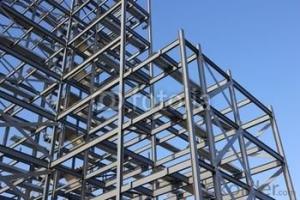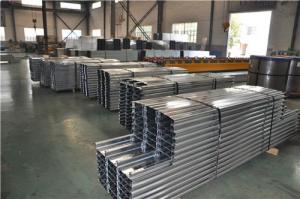Hot Rolled U-channel with High Quality
- Loading Port:
- China Main Port
- Payment Terms:
- TT or LC
- Min Order Qty:
- 25 m.t.
- Supply Capability:
- 10000 m.t./month
OKorder Service Pledge
OKorder Financial Service
You Might Also Like
Product Description:
| Minimum Order Quantity: | 25MT | Unit: | m.t. | Loading Port: | Xingang Port |
| Supply Ability: | 120000TON/Year | Payment Terms: | TT or LC |
Product Applications:
Hot Rolled U-channels are ideal for structural applications and are widely used in the construction of buildings and bridges, and the manufacturing, petrochemical, and transportation industries.
Product Advantages:
OKorder's Hot Rolled U-channels are durable, strong, and resist corrosion.
Main Product Features:
· Premium quality
· Prompt delivery & seaworthy packing (30 days after receiving deposit)
· Corrosion resistance
· Can be recycled and reused
· Mill test certification
· Professional Service
· Competitive pricing
Product Specifications:
Manufacture: Hot rolled
Grade: Q195 – 235
Certificates: ISO, SGS, BV, CIQ
Length: 6m – 12m, as per customer request
Packaging: Export packing, nude packing, bundled
1. We are definitely speciallizing in manufacturing and supplying channel steel as per japanese standard, which is characterised with high mechanical strength and competitive prices.
Original Place | Tangshan, China | Brand Name | UINDA |
Standard | JIS G3192 : 1990 | ||
Material Grade | SS490 | ||
Sizes | 50mm to 200mm | ||
Sales Volume/Year | 3000MT | ||
Destination Area | Middle East, Africa, Southeast Asia | ||
2. The sections in details are as followings in the table-1
JIS U CHANNEL | Standard | Sectional | Dimension |
| Mass: |
| (mm) | (mm) | (mm) | (mm) |
|
50x25 | 50 | 25 | 3.0 | 6.00 | 2.37 |
75X40 | 75 | 40 | 3.8 | 7.00 | 5.30 |
75X40 | 75 | 40 | 4.0 | 7.00 | 5.60 |
75X40 | 75 | 40 | 4.5 | 7.00 | 5.85 |
75X40 | 75 | 40 | 5.0 | 7.00 | 6.92 |
|
|
|
|
|
|
100X50 | 100 | 50 | 3.8 | 6.00 | 7.30 |
100X50 | 100 | 50 | 4.2 | 6.00 | 8.03 |
100X50 | 100 | 50 | 4.5 | 7.50 | 8.97 |
100X50 | 100 | 50 | 5.0 | 7.50 | 9.36 |
|
|
|
|
|
|
125X65 | 125 | 65 | 5.2 | 6.80 | 11.66 |
125X65 | 125 | 65 | 5.3 | 6.80 | 12.17 |
125X65 | 125 | 65 | 5.5 | 8.00 | 12.91 |
125X65 | 125 | 65 | 6.0 | 8.00 | 13.40 |
|
|
|
|
|
|
150x75 | 150 | 75 | 5.5 | 7.30 | 14.66 |
150x75 | 150 | 75 | 5.7 | 10.00 | 16.71 |
150x75 | 150 | 75 | 6.0 | 10.00 | 17.90 |
150x75 | 150 | 75 | 6.5 | 10.00 | 18.60 |
150x75 | 150 | 75 | 6.5 | 10.00 | 24.00 |
|
|
|
|
|
|
200X80 | 200 | 80 | 7.5 | 11.00 | 24.60 |
Table-1
3. The mechanical property of JIS U Channel Steel in the table-2:
Grade | Yield Strength,N/mm² | Extension Strength N/mm² | |||
Thickness of Steel,mm | |||||
≦16 | >16-≦40 | >40-≦100 | >100 | ||
SS490 | ≧285 | ≧275 | ≧255 | ≧245 | 490-610 |
Table-2
4. The chemical composition of JIS U Channel Steel as per SS490 in the table-3
Grade | Element(%) | |||
C | Mn | P | S | |
SS490 | - | - | ≦0.050 | ≦0.050 |
Table-3
FAQ:
Q1: Why buy Materials & Equipment from OKorder.com?
A1: All products offered byOKorder.com are carefully selected from China's most reliable manufacturing enterprises. Through its ISO certifications, OKorder.com adheres to the highest standards and a commitment to supply chain safety and customer satisfaction.
Q2: How do we guarantee the quality of our products?
A2: We have established an advanced quality management system which conducts strict quality tests at every step, from raw materials to the final product. At the same time, we provide extensive follow-up service assurances as required.
Q3: How soon can we receive the product after purchase?
A3: Within three days of placing an order, we will begin production. The specific shipping date is dependent upon international and government factors, but is typically 7 to 10 workdays.
Images:
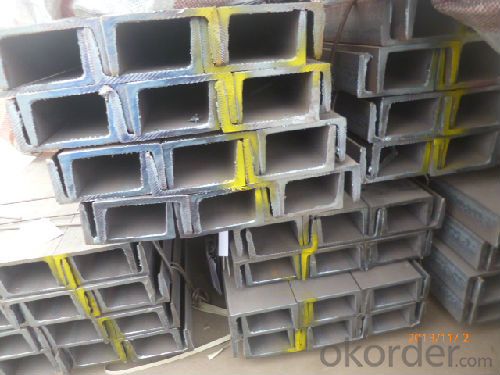
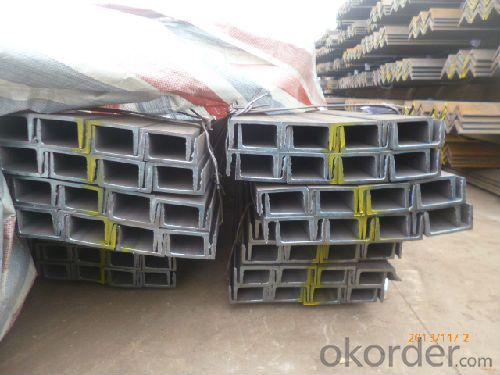
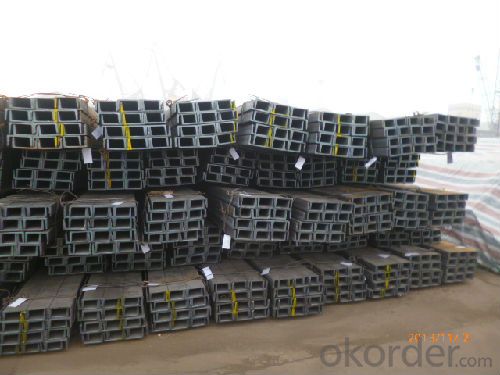
- Q:What are the advantages of using steel in the construction of schools?
- There are several advantages of using steel in the construction of schools. Firstly, steel is known for its durability and strength, making it an ideal choice for structures that need to withstand various natural forces such as earthquakes, hurricanes, and heavy snow loads. This ensures the safety and longevity of the school building. Secondly, steel is a flexible material that allows for versatile architectural designs. It can be easily molded and fabricated into different shapes and sizes, offering architects and designers the freedom to create innovative and visually appealing school buildings. Additionally, steel construction is relatively faster compared to traditional construction methods. Prefabricated steel components can be manufactured off-site and then assembled on-site, reducing construction time significantly. This not only saves time but also reduces labor costs. Moreover, steel is an environmentally friendly material. It is 100% recyclable, and the steel industry has a high recycling rate, making it a sustainable choice for construction. Using steel in schools helps to reduce the environmental impact of construction and supports a greener future. Finally, steel structures require minimal maintenance and are resistant to pests, decay, and fire. This reduces the long-term maintenance costs of the school building, allowing more resources to be allocated towards educational purposes. Overall, the advantages of using steel in the construction of schools include durability, flexibility in design, faster construction, sustainability, and low maintenance, making it an excellent choice for educational buildings.
- Q:Can steel structures be designed to be resistant to corrosion from alkaline substances?
- Yes, steel structures can be designed to be resistant to corrosion from alkaline substances. This can be achieved through various measures such as using corrosion-resistant coatings, selecting appropriate grades of stainless steel, employing cathodic protection systems, and implementing proper maintenance practices. These strategies help to prevent or slow down the corrosion process caused by alkaline substances, ensuring the durability and longevity of the steel structure.
- Q:What are the common types of steel cladding used on steel structures?
- The common types of steel cladding used on steel structures are galvanized steel, stainless steel, and weathering steel.
- Q:How are steel structures used in the construction of communication towers?
- Steel structures are commonly used in the construction of communication towers due to their strength, durability, and versatility. Steel provides a stable and rigid framework for supporting the antennas and equipment necessary for communication. It can withstand extreme weather conditions and can be easily modified or expanded to accommodate changing technology or additional equipment. Additionally, the lightweight nature of steel allows for easier transportation and installation of communication towers.
- Q:What are the different factors considered in the design of a steel structure?
- Some of the different factors considered in the design of a steel structure include the intended use and load requirements of the structure, the site conditions and environmental factors such as wind, snow, and seismic loads, the material properties and strength of the steel used, as well as considerations for construction methods and cost. Additionally, factors like aesthetics, durability, maintenance requirements, and sustainability may also be taken into account in the design process.
- Q:What does the steel structure lug 2-240*290*12 mean?
- Steel structure connecting lug 2-240*290*12 means 2 pieces, steel plate of thickness 12MM, length 290MM, width 240MM.Steel structure is mainly made of steel material, and it is one of the main types of building structure. The structure is mainly composed of steel beams and steel plates, such as steel beams, steel columns, steel trusses and so on. Each component or component is usually connected with welds, bolts or rivets. Because of its light weight and simple construction, it is widely used in large factories, stadiums, super high-rise and other fields.
- Q:What are the common design considerations for steel structures in educational facilities?
- Some common design considerations for steel structures in educational facilities include the need for flexible and adaptable spaces to accommodate changing educational requirements, ensuring the structures are durable and able to withstand heavy loads, incorporating energy-efficient features to reduce operational costs, providing adequate natural light and ventilation for a conducive learning environment, and ensuring compliance with safety codes and regulations, such as fire safety measures and accessibility requirements. Additionally, considerations may also include the integration of technology infrastructure, the provision of comfortable and ergonomic furniture, and the incorporation of sustainable design principles to minimize the environmental impact of the facility.
- Q:What are the design considerations for steel waste management facilities?
- Design considerations for steel waste management facilities include: 1. Structural Integrity: Steel waste management facilities must be designed to withstand the weight and impact of the waste materials being stored or processed. The structure should be able to support heavy machinery and equipment used in waste management operations. 2. Corrosion Resistance: Steel structures in waste management facilities are exposed to various corrosive elements, such as chemicals and moisture. Therefore, the design should incorporate corrosion-resistant materials, coatings, or protective measures to ensure the longevity of the facility. 3. Ventilation and Odor Control: Proper ventilation systems are crucial to control odors and prevent the buildup of hazardous gases in waste management facilities. The design should include adequate ventilation systems that comply with health and safety regulations, ensuring a safe working environment for employees and minimizing odors that could impact nearby communities. 4. Waste Segregation and Storage: The layout and design of the facility should consider the efficient segregation and storage of different types of waste. This may involve separate areas for hazardous, non-hazardous, or recyclable waste, as well as proper labeling and signage to ensure waste is stored correctly. 5. Fire Safety: Waste materials can be highly flammable and pose a significant risk of fire. The design should include fire detection and suppression systems, as well as fire-resistant construction materials to minimize the spread of fire and protect the facility, surrounding areas, and personnel. 6. Accessibility and Safety: The design should prioritize safe and accessible pathways for employees and waste management vehicles. This includes considering the flow of traffic within the facility, providing appropriate loading and unloading areas, and ensuring proper access for emergency vehicles. 7. Environmental Impact: Steel waste management facilities should be designed with sustainability and environmental impact in mind. This may include incorporating energy-efficient systems, waste recycling processes, and water conservation measures. Additionally, the facility should comply with environmental regulations and minimize the risk of pollution or contamination. 8. Future Expansion and Flexibility: The design should account for potential future growth or changes in waste management operations. This may involve considering the facility's scalability, modular construction, or flexible layouts to accommodate future expansion or modifications. Overall, the design of steel waste management facilities should prioritize safety, efficiency, and environmental responsibility while meeting regulatory requirements and industry best practices.
- Q:What are the common methods of steel structure construction?
- The common methods of steel structure construction include bolted connections, welded connections, and pre-engineered buildings. Bolted connections are one of the most commonly used methods in steel construction. This involves using bolts to connect steel components together. Bolted connections offer flexibility and ease of assembly, making them suitable for a wide range of construction projects. They can also be easily disassembled and reassembled, allowing for modifications or additions to the structure. Welded connections involve the fusion of two or more steel components using heat and pressure. This method provides high strength and rigidity to the structure. Welded connections are commonly used in applications where the structure requires maximum strength and stability, such as high-rise buildings, bridges, and industrial facilities. However, welding requires skilled labor and specialized equipment, making it a more time-consuming and costly construction method. Pre-engineered buildings are another common method of steel structure construction. These buildings are fabricated off-site in a factory and then assembled on-site. Pre-engineered buildings offer a cost-effective and efficient solution for a variety of applications, including warehouses, garages, and agricultural buildings. They are designed and manufactured to meet specific requirements, allowing for faster construction and reduced labor costs. In addition to these methods, steel structures can also be constructed using a combination of bolted and welded connections, depending on the specific project requirements. Each method has its advantages and limitations, and the choice of construction method depends on factors such as project scope, budget, timeline, and structural requirements.
- Q:How are steel structures used in residential complexes?
- Steel structures are commonly used in residential complexes for their strength, durability, and versatility. They provide the framework for buildings, including columns, beams, and trusses, ensuring stability and safety. Steel structures allow for open floor plans, large spans, and flexible layouts. They are also resistant to fire, pests, and decay, offering long-term cost savings and minimal maintenance. Additionally, steel structures can be prefabricated off-site, speeding up construction time and reducing on-site disruptions.
1. Manufacturer Overview |
|
|---|---|
| Location | |
| Year Established | |
| Annual Output Value | |
| Main Markets | |
| Company Certifications | |
2. Manufacturer Certificates |
|
|---|---|
| a) Certification Name | |
| Range | |
| Reference | |
| Validity Period | |
3. Manufacturer Capability |
|
|---|---|
| a)Trade Capacity | |
| Nearest Port | |
| Export Percentage | |
| No.of Employees in Trade Department | |
| Language Spoken: | |
| b)Factory Information | |
| Factory Size: | |
| No. of Production Lines | |
| Contract Manufacturing | |
| Product Price Range | |
Send your message to us
Hot Rolled U-channel with High Quality
- Loading Port:
- China Main Port
- Payment Terms:
- TT or LC
- Min Order Qty:
- 25 m.t.
- Supply Capability:
- 10000 m.t./month
OKorder Service Pledge
OKorder Financial Service
Similar products
New products
Hot products
Related keywords






















